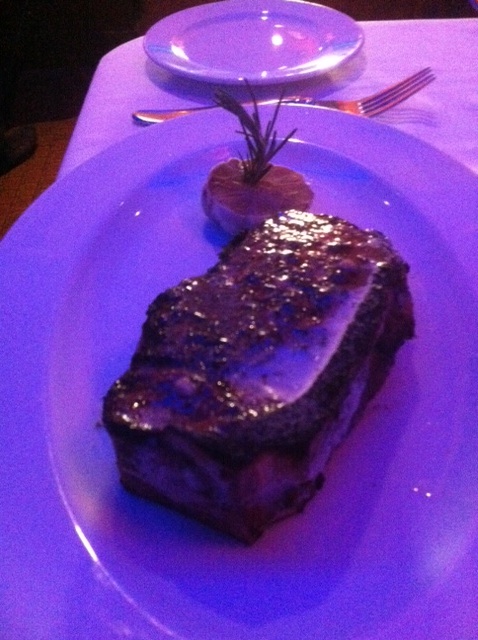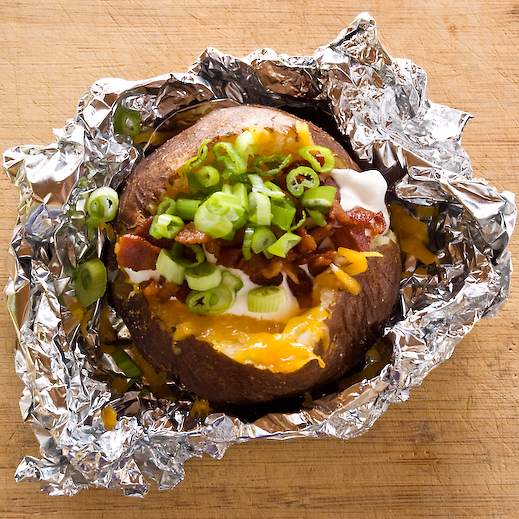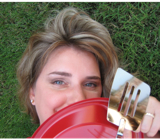Super Sister-in-Law Chef Sandy is back today with a recipe and tips for making your own amazing bread (like they serve in the best steakhouses) at home.
One of my criteria for any great restaurant is the quality of its bread. Now, thanks to some genius bakers, it’s totally possible for you to make great bread at home, to go with your fantastic steaks and side dishes. Who needs to eat out, anyways?
I use a recipe created by Jeff Hertzberg, MD and Zoe Francois from their book Artisan Bread in Five Minutes a Day. Because I live above 6000 ft, I have made a few adaptations, like reducing the yeast, and because I am a recipe-tinkerer from way back, I add a few things in for my family. My only other secret is to use King Arthur Flours, because I am a believer in the quality of their products. I use at least ½ King Arthur Whole Wheat flour, and add a little extra water. Sometimes, I will add whey from the yogurt that is in my fridge as part of the liquid, if I have it.
The reason this recipe is so wonderful, besides the fact that it is tasty, is that it truly is easier than any other bread recipe I have ever tried. I get more consistent results from this recipe than I ever got from my bread maker, plus I have a gorgeous, crusty, delicious loaf of bread instead of a square loaf with a hole in the bottom.
If you’re not familiar, the concept behind the “5 Minute” breads is that they are mixed and kept in the fridge, in large batches, for up to 2 weeks. This time in the fridge develops a slight tang, makes the dough easier to work with and the moist dough makes the artisanal bread crust and moist “crumb.” The recipe makes enough dough for 4 small loaves of bread.
I used to be better about following instructions, like “use a baking stone,” but since I lost mine during the move, I just use an upside-down cookie sheet, preheated in my oven to bake this bread. I baked this bread just recently and shared with a good friend who has a little boy who is just learning to talk – he loved this bread and called for “more dat.” I second that motion!
Although the Master Recipe from Artisan Bread in Five Minutes a Day is great, here is my version of the bread, made with ½ whole wheat flour:
3½ cups lukewarm water
1½ Tbsp granulated yeast
1½ Tbsp kosher salt
3 cups King Arthur Bread Flour
3 cups King Arthur Whole Wheat Flour
½ cup wheat germ
(Note – for high altitude, I reduce the amount of yeast to 1 Tbsp.)
In a 5 or 6 quart bowl or lidded food storage container, dump in most of the water (3 cups) and add the yeast and salt. Dump in the flour all at once and stir with a long handled sturdy wooden spoon, a silicone spatula or a Danish Dough Hook. The rest of the water should be added, as needed, depending on your climate/altitude/flour choice. When you mix the dough, let it rest for about 5 minutes to see if it relaxed into the shape of the container – if you can’t easily mix in the flour, you will definitely need to add additional water. This is not dough that requires a mixer to come together.
Stir it until all of the flour is incorporated into the dough. The dough will be looser than most bread doughs you have seen – it will flatten out and take the shape of the bowl or container quickly – not cake batter thin, but looser than cookie or most bread doughs you may have worked with. Because I work with King Arthur Flour, live in a dry climate, and use about ½ whole wheat flour, I usually end up adding about ½ to ¾ cup more liquid than the original recipe calls for.
Allow the dough to sit at room temperature for about 2 hours to rise. When you first mix the dough it will not occupy much of the container, but after the initial rise it will almost fill it. Don’t punch it down, just cover it loosely, with plastic wrap or set the lid of the container on top of it. I use a plate on top of my large bowl to give a cover without sealing the dough in. Set it in the refrigerator to chill for at least 4 hours for the easiest handling.
The next day when you pull the dough out of the refrigerator you will notice that it has collapsed – this is normal for this dough. Dust the surface of the dough with a little flour, just enough to prevent it from sticking to your hands when you reach in to pull a piece out.
Cut off a 1-pound piece of dough using kitchen shears and form it into a ball.
To shape the dough, grab your mass of dough – about the size of a large grapefruit for a one-pound loaf of bread, and sort of tuck all of the ends around to the bottom of the mass of dough and stretch a “cloak” of dough around the ball. If you are shaping the dough into rolls, now is the time to do this – for nice dinner rolls, cut the ball of dough into 6 pieces and form each of these into a neat little ball. You may need to dust your hands with a little flour, or counter-intuitively, wet them, to get a nice shape – the quicker you move here, the easier, I promise.
If you want to add something like olives to the bread, you can either mix it into the dough (at the first mix,) or sort of roll it in, jelly roll style. For bread to enjoy with a nice steak dinner, I’d go simple. Leave some good quality salted butter on the counter to soften to room temp while you cook.
Place the ball of dough on a sheet of parchment paper… (or rest it on a generous layer of corn meal on top of a pizza peel.)
Let the dough rest for at least 40 minutes, or 60 or even 90 minutes. It won’t rise much, but that is how the recipe was designed. Longer rests will allow the center of the loaf to be less dense, with larger holes. Preheat the oven to 450 degrees with a baking stone on the center rack, with a metal broiler tray on the bottom (never use a glass vessel for this or it will shatter), which will be used to produce steam. (The tray needs to be at least 4 or 5 inches away from your stone to prevent it from cracking.) If you don’t have a pizza stone, use a cookie sheet, upside down, on the center rack.
Slash the loaf deeply (1/2 inch or so, with scissors or a serrated knife) to prevent splitting.
Slide the loaf into the oven onto the preheated stone and add a cup of hot water to the broiler tray. Bake the bread for 30-35 minutes or until a deep brown color. As the bread bakes you should notice a nice oven spring in the dough. This is where the dough rises.
If you used parchment paper you will want to remove it after about 20-25 minutes to crisp up the bottom crust. Continue baking the loaf directly on the stone for the last 5-10 minutes.
Allow the loaf to cool on a rack until it is room temperature.
If you have any leftover bread just let it sit, uncovered on the cutting board or counter with the cut side down.
Enjoy!



